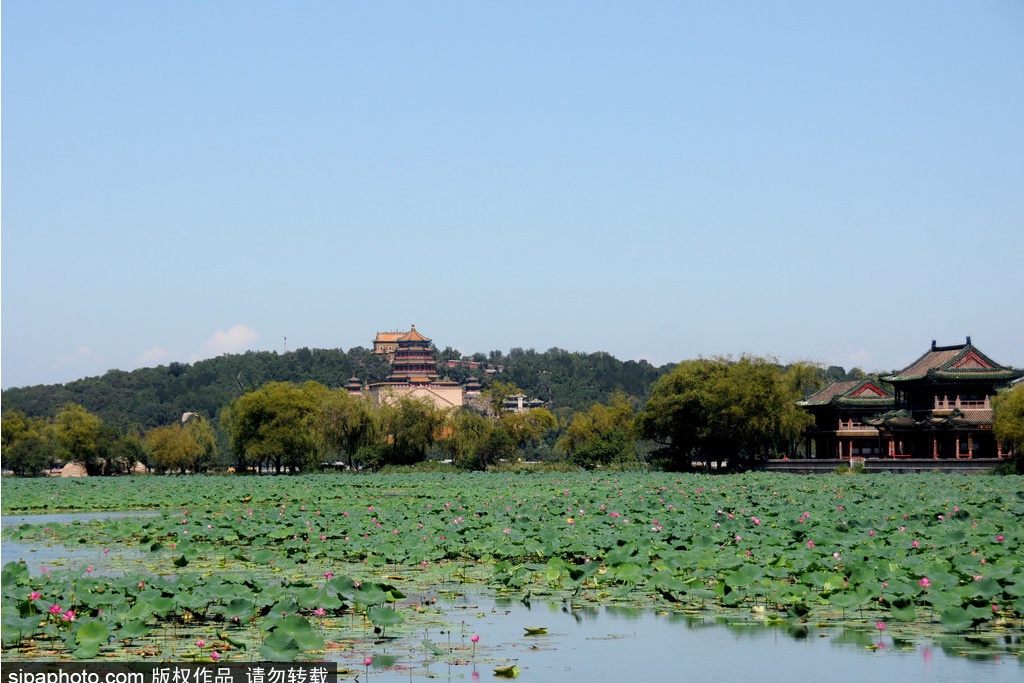
Rating:AAAAA
Key Words:World Cultural Heritage,Spring Outing,Landscape,
The Summer Palace is the largest existing and the best-preserved royal garden in China, was one of the “Three Hills and Five Gardens” in the western suburbs of Beijing
Description:
The Summer Palace is a vast ensemble of lakes, gardens and palaces in Beijing. Mainly dominated by Longevity Hill and Kunming Lake, it covers an expanse of 2.9 square kilometers, three-quarters of which is water. In December 1998, UNESCO included the Summer Palace on its World Heritage List. It declared the Summer Palace "a masterpiece of Chinese landscape garden design. The natural landscape of hills and open water is combined with artificial features such as pavilions, halls, palaces, temples and bridges to form a harmonious ensemble of outstanding aesthetic value".
Located in the northwest outskirts of Beijing, 15 km from the city, the Summer Palace is originally named "Qingyiyuan" (Gardens of Clear Ripples). Based on the scenery of West Lake as the chief source, the garden absorbs the design method as well as the artistic conception of traditional southern Chinese garden. It gets the reputation of the “museum of the royal garden”. The Summer Palace, originally named Qingyi Yuan or the Garden of Clear Ripples, is the largest existing and the best-preserved royal garden in China. In the Qing Dynasty, it was one of the “Three Hills and Five Gardens” in the western suburbs of Beijing.
As the largest royal garden of the Qing Dynasty, it features wonderful scenery in four seasons. The palace gets more mild and colorful in autumn, the hue of which turns into warm colors like yellow, orange and red. Palaces sheltered in the warm color plants are especially charming. Also, some fallen leaves are floating over the water.
The most attracting water landscape in the Summer Palace lies on the Kunming Lake, where boasts vast waters and picturesque landscape. With gentle breeze and ripples, visitors can sail on the lake in summertime. While in warm days, a standing by the lakeside provides a broad view, some tourists are on powerboats and gaily-painted pleasure-boats, and others are oaring their way on small boats. With the reflection of bridges, islands, palaces and pavilions, the lake becomes vigorous and vibrant.
Wenchang Tower (Wenchang Ge )文昌阁
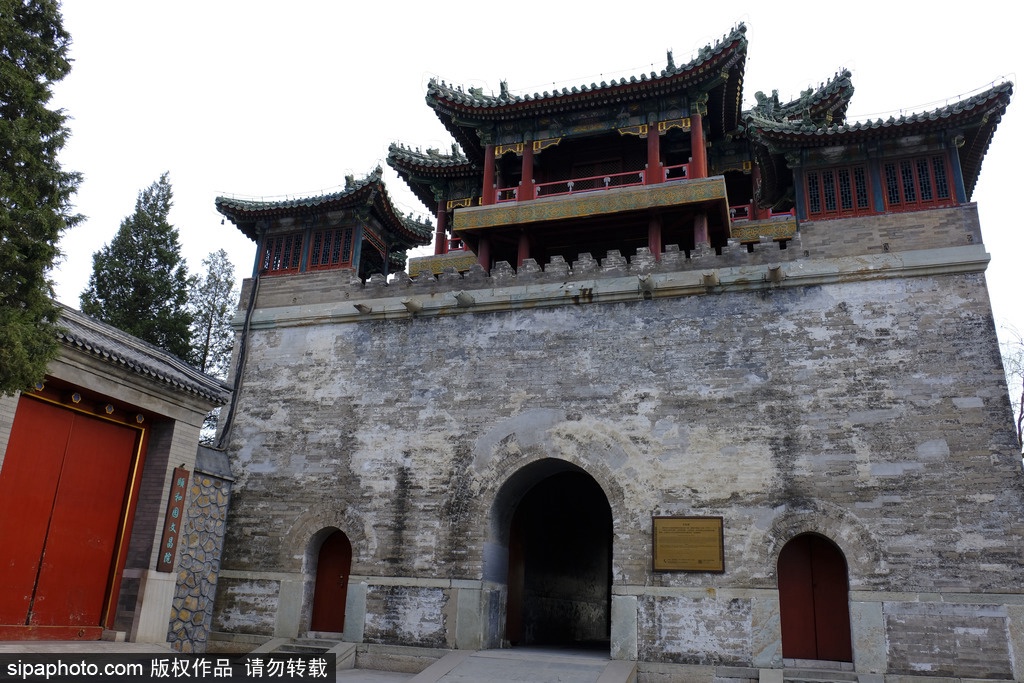
The biggest of the six gate forts(Purple Cloud Tower、Tower of Cloud-Retaining Eaves、Tower of Dawn Light、Tongyun Chengguan、Qianfengcaicui Chengguan、Wenchang Tower)in the Summer Palace garden, the Wenchang Tower was first built in the 15th year of Emperor Qianlong’s reign (1750) and rebuilt under Emperor Guangxu after it was burned down in 1860 by the Anglo-French Allied Forces. A bronze statue of the god, Wenchang, and statues of two followers, the celestial boy, and the bronze steed, were placed in the two-storey pavilion. This tower pairs up with the Tower of Cloud-Retaining Eaves, located on the west bank of Kunming Lake, in which a statue of the Martial God was placed. The twin towers symbolize the support by both scholars and warriors to the ruling emperor.
Seventeen-Arch Bridge (Shiqi Kong Qiao)十七孔桥

Built in the 15th year of Emperor Qianlong’s reign (1750), this 150-meter bridge links the east bank and the South Lake Island. It is the longest bridge in any Chinese imperial garden and was named for its seventeen arches. Over 500 stone lions in different poses are carved on the posts of the bridge’s railings. At both ends of the bridge are carved four strange animals. Strong and powerful, they are outstanding evidence of Qing stone carving.
Kunming Lake (Kunming Hu)昆明湖
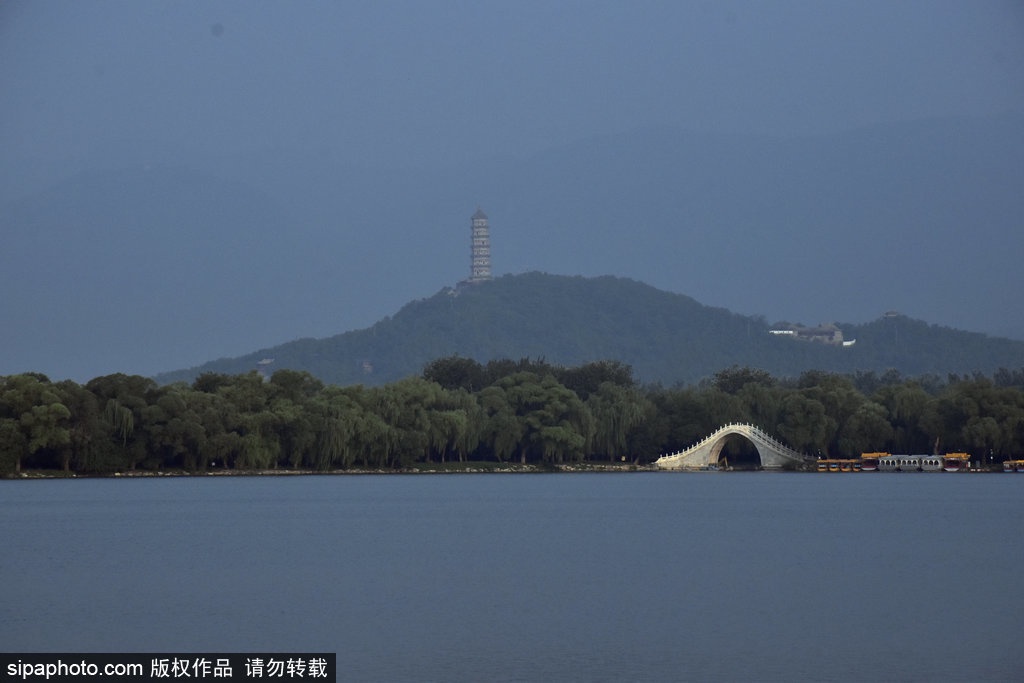
Kunming Lake, once a natural lake where numerous mountain springs in the northwest of Beijing converged, was previously known as Great Lake, Jar Hill Lake, etc. After Beijing became the capital city of the Yuan Dynasty, Guo Shoujing, an expert in irrigation works at the time, supervised the redirection of the spring water from the Divine Mountains in Changping, to the lake. The spring water, drawing in the tributary waters along the way, made the lake into a reservoir that greatly facilitated the transportation of grain. During the Ming Dynasty, a large number of lotus flowers were planted in the lake. In the surrounding area were rice paddies, temples, pavilions and other finely built structures, creating a great view that resembled the landscape of south China. For this reason it became known as the West Lake, after its namesake in the southern city of Hangzhou. With construction of the Garden of Clear Ripples during Emperor Qianlong’s reign (1736-1795), the lake was expanded to its current size. Emperor Qianlong then named it “Kunming”, inspired by Emperor Liuche of the Han Dynasty, who once constructed an artificial lake called the “Kunming Pool” to practise battles on the water. The current lake covers an area of over 200 hectares, making up three quarters of the whole garden. In accordance with the “three islands in one pool” principle for the design of water features in imperial gardens, three islands were built on the lake, namely, the “South Lake Island”, the “Mirror of Government Tower” and the “Hall of Recognition of Talent Island”. The West Causeway, imitating the Su Causeway of the West Lake in Hangzhou, was also constructed. The glistening waters, the meandering banks, well-arranged islands, and a host of architectural structures in different styles, both near and far, all combine to present a wonderful view of the Summer Palace landscape, a view dominated by Kunming Lake. Scientific research in the 1990s showed that the lake dates back over 3,500 years.
West Causeway(Xidi)西堤
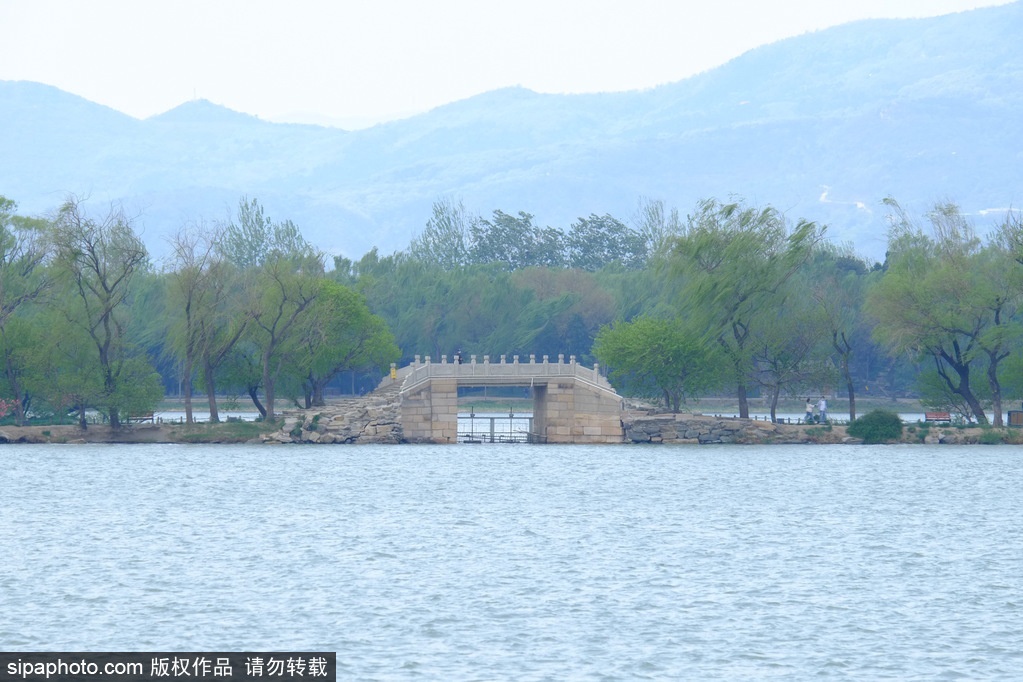
The West Causeway is modeled on the Su Causeway of the West Lake in Hangzhou. From north to south, the causeway is connected by six bridges, each unique in style: the Lake-Dividing Bridge, the Bridge of Pastoral Poems, the Jade Belt Bridge, the Mirror Bridge, the Silk Bridge and the Willow Bridge. Between the Silk Bridge and the Willow Bridge is the Pavilion of Bright Scenery. It was named after the essay, On the Yueyang Tower, a famous piece by Fan Zhongyan, a well-known writer of the Song Dynasty. He wrote, “the spring is peaceful and the scenery bright; the waves are asleep”. Peach and willow trees were planted on the causeway so that when spring came, the green of the willow trees and the red of the peach blossoms would combine to recreate the scenery of south China.
South Lake Island (Nanhu Dao)南湖岛
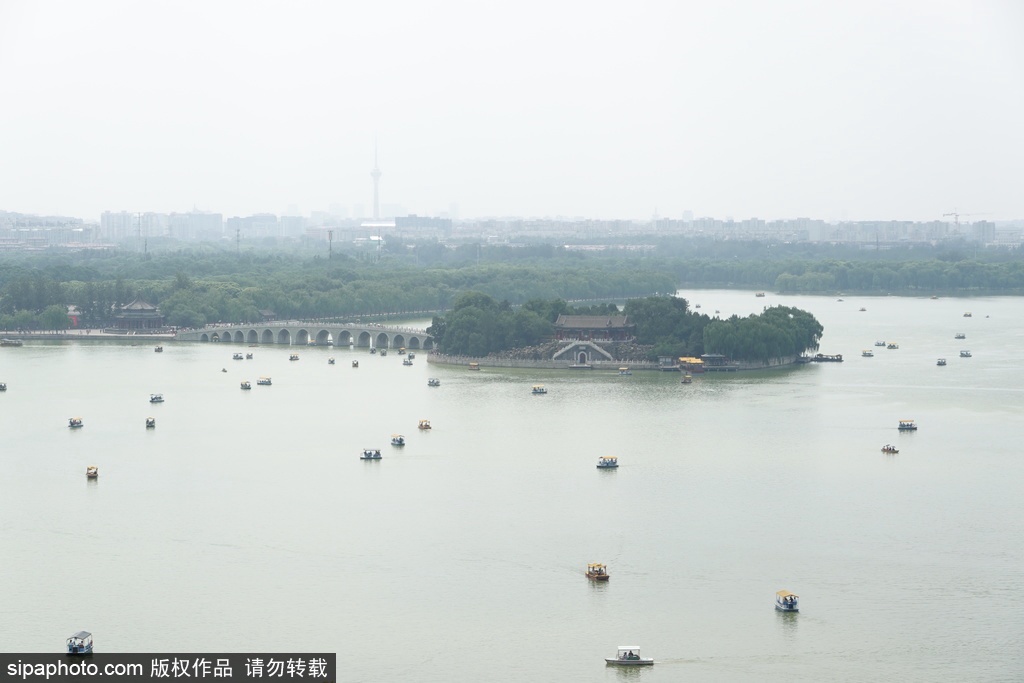
Situated in the center of the lake, the island is connected to the Spacious Pavilion on the east bank by the Seventeen-Arch Bridge. The island, the bridge and the pavilion combine to form an integrated architecture that echoes the Longevity Hill from a distance. The scenic spots which stand on the island include the Hall of Embracing the Universe, the Dragon King Temple, the Hall of Foresight, the Tower of Moonlit Ripples and the Chamber of Heartfelt Contentment.
Bronze Ox (Tongniu)铜牛
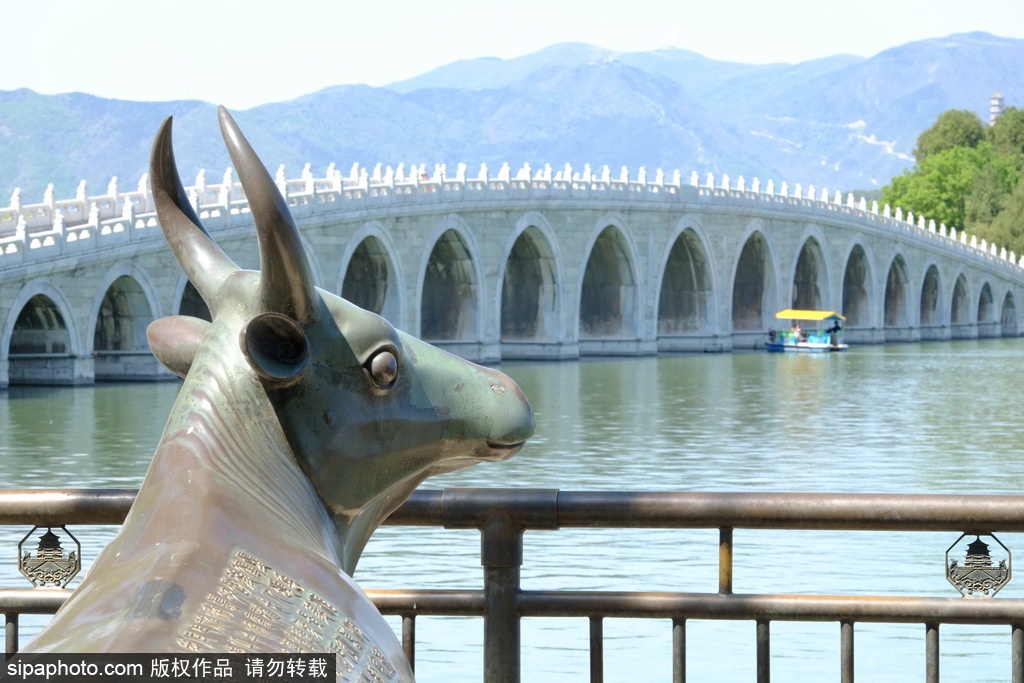
Cast in the 20th year of Emperor Qianlong’s reign (1736-1795), this statue was also called the “Golden Ox”. Crouching on the carved stone base, the bronze ox has a lifelike bearing. It is said that the bronze ox was positioned here to keep the floods down. Inscribed on the back of the ox is an ode of eighty words entitled “Inscriptions on the Golden Ox”. It was written by Emperor Qianlong in a traditional style of Chinese calligraphy known as seal characters.
Kunlun Stone (Kunlun Shi)昆仑石
This stone was erected during the reign of Emperor Qianlong. It was inscribed with a poem written by Emperor Qianlong, which depicts the historical changes of the East Bank. The East Bank of Kunming Lake was once the protective bank for Changchun Garden, one of the well known “three hills and five gardens” in the western suburbs of Beijing. Therefore, a line of the poem says: “Now the west bank becomes the east bank, and the origin of names and substances can all be ascertained.”
Erected during Emperor Qianlong’s reign (1736-1795), the inscription on this stone stele is the reproduction of a poem written by Emperor Qianlong. The poem depicts the changing scenery of the long river banks which he enjoyed so much when he came to the garden by boat.
Tower of the Fragrance of the Buddha (Foxiang Ge)佛香阁
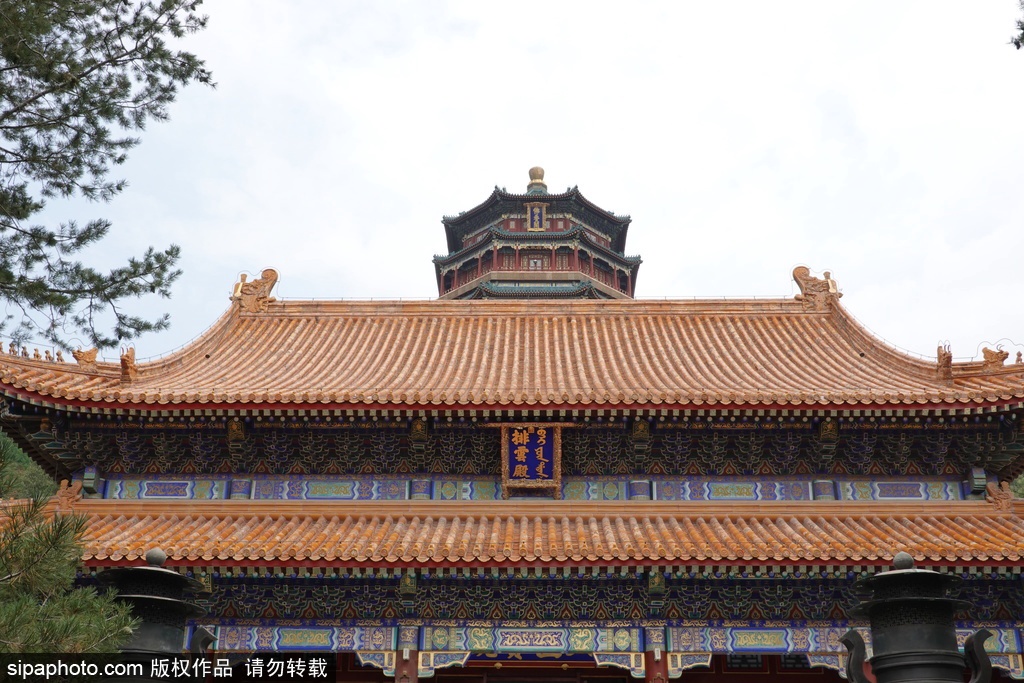
Originally built during the reign of Emperor Qianlong and burned down by the Anglo-French Allied Forces in 1860, it was rebuilt in its original style during Emperor Guangxu’s reign (1875-1908). The octahedral tower has three stories with four-layered eaves, altogether 36.44 meters high. Standing upright on a 20 meter-high stone foundation, it constitutes the center of the Summer Palace landscape and serves to accentuate its magnificence. A statue of the thousand-handed Guanshiyin Buddha, cast in bronze and gilded with gold, stands inside the tower. The statue, five meters high and five tons in weight, was cast during the reign of Emperor Wanli of the Ming Dynasty. Set off by the eight imposing pillars which support the tower, it glows with beauty, grandeur and brilliance. Its historical, cultural and artistic value can hardly be overstated.
Hall that Dispels the Clouds (Paiyun Dian)排云殿
The original construction here was the Hall of the Great Buddha of the Temple of Immense Gratitude and Longevity in the Garden of Clear Ripples. It was burned down by the Anglo-French Allied Forces in the 10th year of Emperor Xianfeng’s reign (1860) and reconstructed on its original site in the 12th year of Emperor Guangxu’s reign (1886) as a place to celebrate Empress Dowager Cixi's birthdays. On display inside the hall are some of the birthday presents offered by princes, dukes and high-ranking officials.
Long Corridor (Chang Lang)长廊
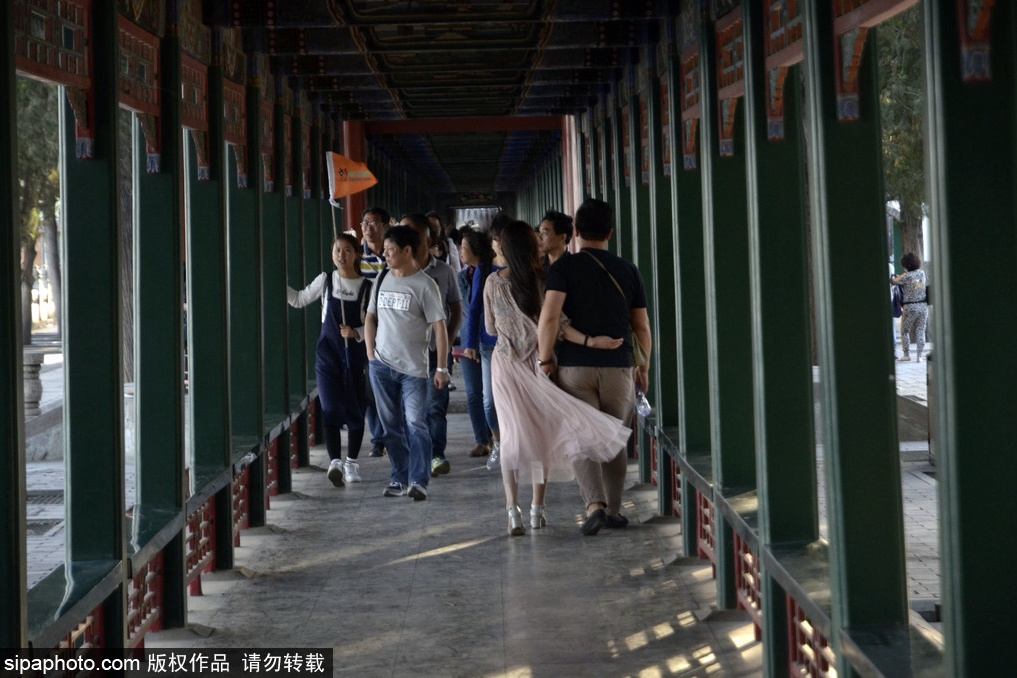
The Long Corridor was originally built in the 15th year of Emperor Qianlong’s reign (1750) and then rebuilt in the 12th year of Emperor Guangxu’s reign (1886) because the Anglo-French Allied Forces burned it down in 1860. It starts from Inviting the Moon Gate in the east and ends at Shizhang Pavilion in the west, covering a distance of 728 meters with its 273 sections. Of all the corridors in Chinese classical gardens, the Long Corridor is the longest. On the beams are more than 8,000 colorful paintings depicting stories from Chinese classical novels, folk tales, landscapes as well as flora and fauna. Four pavilions, “Mesmerizing Scenery”, “Harmonizing with the Lake”, “Autumn Water” and “Clear and Carefree”, with octahedral structures and double eaves, were built intermittently along the corridor. Taking the Hall that Dispels the Clouds as the center, the Long Corridor stretches symmetrically to the east and the west along the foot of the hill and the water bank, linking all the structures scattered along the Longevity Hill side into a whole.
Hall of Happiness in Longevity (Leshou Tang)乐寿堂
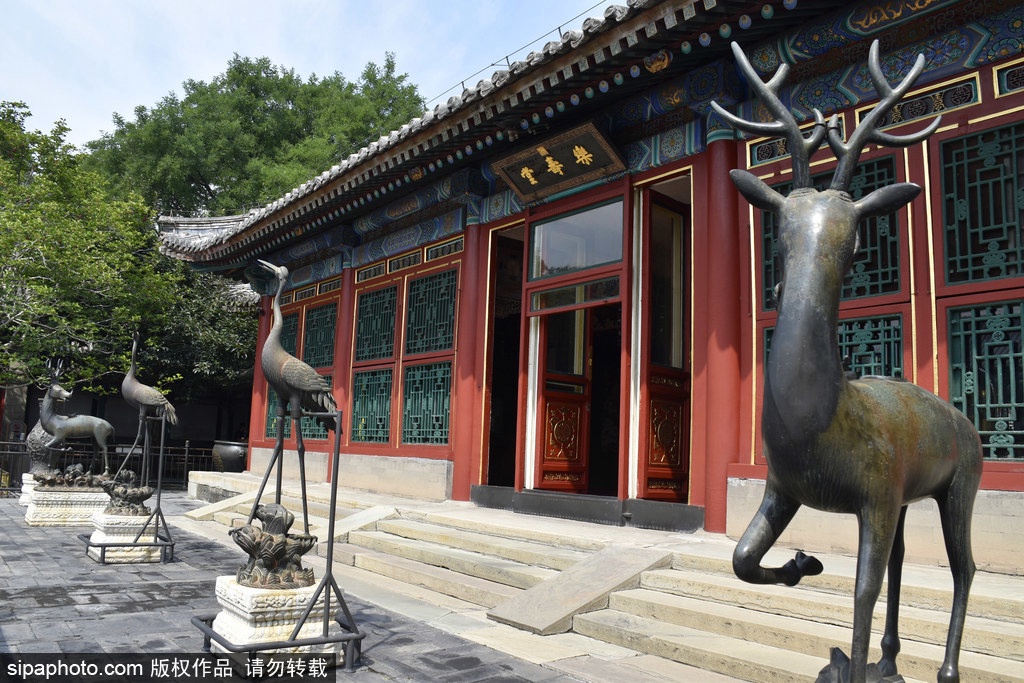
Built in the 15th year of Emperor Qianlong’s reign (1750), the Hall of Happiness in Longevity originally had two floors. Burned down by the Anglo-French Allied Forces in the 10th year of Emperor Xianfeng’s reign (1860), it was reconstructed in the 12th year of Emperor Guangxu’s reign (1886) to serve as the living quarters for Empress Dowager Cixi during her stay in the Summer Palace.
Hall of Benevolence and Longevity (Renshou Dian)仁寿殿
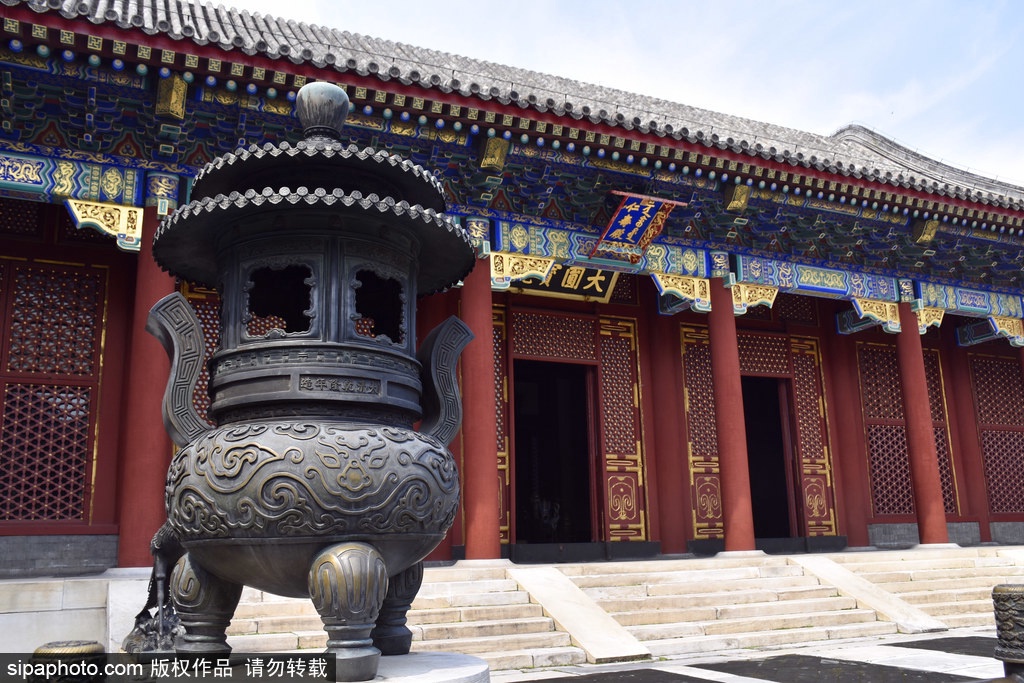
First built in the 15th year of Emperor Qianlong’s reign (1750) during the Qing dynasty, this building was named the Hall of Diligent Government when the whole Summer Palace area was called the Garden of Clear Ripples. In the 12th year of Emperor Guangxu’s reign (1886), the Hall was rebuilt where it had been before the Anglo-French Allied Forces burned it down in the 10th year of Emperor Xianfeng’s reign (1860). Citing the saying “the benevolent enjoy longevity”from the Analects of Confucius, it was renamed the Hall of Benevolence and Longevity. This was where Empress Dowager Cixi and Emperor Guangxu handled court affairs, accepted laudations and received foreign diplomats during their stay in the Summer Palace. As such, it was the Summer Palace’s main government building.1898,Emperor Guangxu met Kang Youwei,leader of the reformers,and appointed him reform counselor,declaring an institutional reform.
Longevity Chamber (Yongshou Zhai)永寿斋
During the reign of Emperor Guangxu, this chamber, along with the courtyard, was built adjacent to the Empress Dowager’s sleeping quarters, the “Hall of Happiness in Longevity”. Popularly known as “the Chief’s Courtyard”, it served as the living quarters for Li Lianying, chief of the court eunuchs at the end of the Qing Dynasty. Li is trusted eunuch of Empress Dowager Cixi, his building is most magnificent.
Yiyun Hall (Yiyun Guan)依云馆
Yiyun means the collection of books. The hall was originally built in the 15th year of Emperor Qianlong’s reign (1750) with two side wings, each with five bays. The east wing was named the “Method Keeping Room” and the west one was named the “Nearing the West Room”. Burned down by the Anglo-French Allied Forces in the 10th year of Emperor Xianfeng’s reign (1860), it was rebuilt in the 12th year of Emperor Guangxu’s reign (1886) to serve as a residence for the Empress.
These were the living quarters for Empress Long Yu when she, as Emperor Guangxu’s wife, stayed in the Summer Palace. A niece of the Empress Dowager Cixi, she had the title of Empress bestowed on her in the first month of the 15th year of Emperor Guangxu’s reign (1889). When Emperor Guangxu and the Empress Dowager Cixi died of ill health and Puyi became Emperor in 1908, she was elevated to the position of Empress Dowager under the imperial title of Long Yu. In this capacity, she issued an order to give up the throne in 1911 after the Wuchang Uprising.
Hall of Jade Ripples (Yulan Tang)玉兰堂
Originally built in the 15th year of Emperor Qianlong’s reign (1750) with passageways in all directions, the hall was burned down by the Anglo-French Allied Forces in the 10th year of Emperor Xianfeng’s reign (1860). It was reconstructed in the 12th year of Emperor Guangxu’s reign (1886) as the emperor’s living quarters. Following the failure of the 1898 Reforms under Emperor Guangxu, Empress Dowager Cixi ordered that the courtyard be blocked off, thereby converting it into a place for keeping the Emperor under house arrest.
Wenchang Gallery(Wenchang Yuan )文昌院

Located to the east of the Wenchang Tower in the Summer Palace, the Wenchang Gallery is the largest and the most impressive gallery of its kind in any classical Chinese garden.
On display in its six halls are thousands of artifacts extracted from the Summer Palace, covering some 3,600 years from the Shang and Zhou dynasties to the fall of the Qing Dynasty in 1911. The exhibits include bronzeware, jewelry, chinaware, furniture, paintings, calligraphy, ancient books, enamels, clocks, handicrafts made of gold, silver, bamboo, wood, ivory, horn and lacquer, and other miscellaneous items, representing almost all types of Chinese antiques. As one would expect in an imperial garden, these artifacts demonstrate the highest techniques and craftsmanship of their times, and many were once highly important symbols of the state. Also on display in the halls are objects related to the everyday life of emperors and empresses in the Qing court. They are of great historical value and provide some of the most reliable material evidence of the court culture in imperial China.
East Palace Gate东宫门
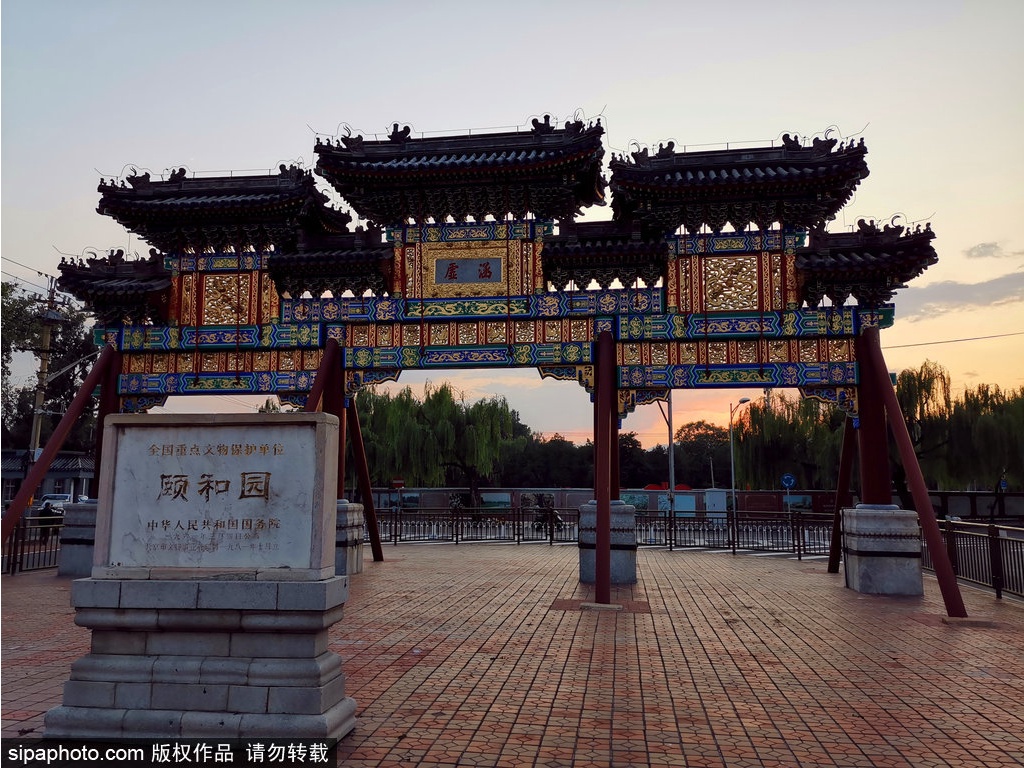
The East Palace Gate ,oriented to the east,is the front gate of the Summer Palace .For a time it was reserved exclusively for the use of the Qing emperors and empresses.Hanging under the eaves of the gateway is a gilded nameboard decorated with nine dragon paterns an inscribed with the three Chinese characters”Yi He Yuan”in the calligraphy of Emperor Guangxu.
Longevity Hill (Wanshou Shan)万寿山
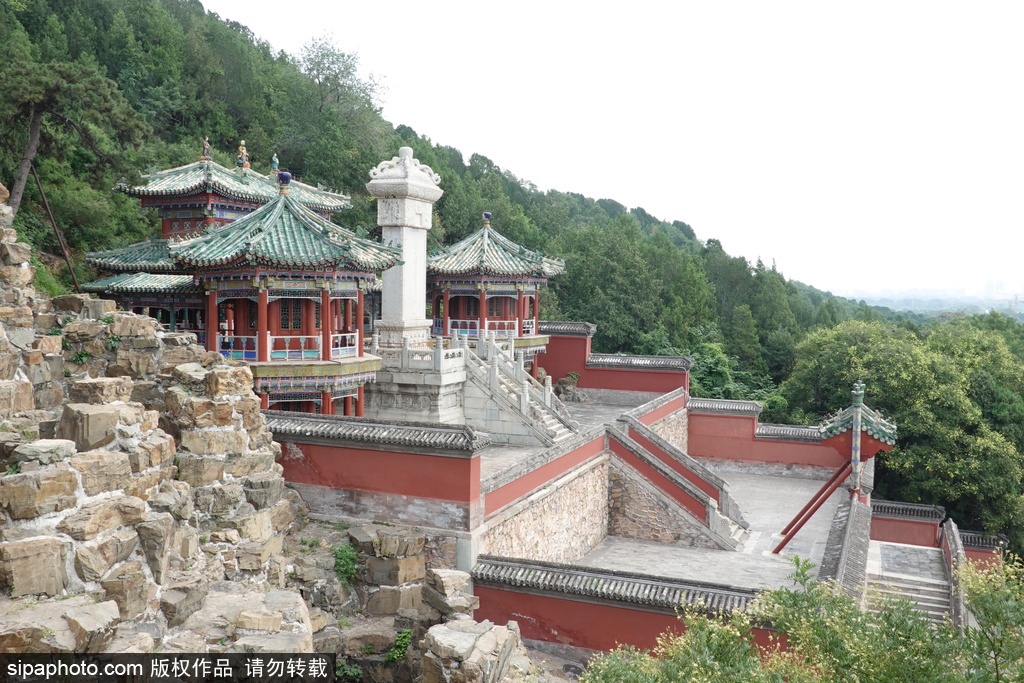
Longevity Hill, 58.59 meters high, is an offshoot of the Yan Mountain range. Legend has it that an old man found a stone jar while chiseling at the hill rocks. The hill was therefore named Jar Hill and the lake before it, Jar Hill Lake. Also named West Lake, the lake in time came to be known as Kunming Lake. In the 7th year of the reign of Emperor Hongzhi (1494) of the Ming Dynasty, the emperor’s wet nurse, Madam Luo, built a temple at the foot of the mountain, which she named the Temple of Serenity. In the 15th year of Emperor Qianlong’s reign (1750), the Temple of Immense Gratitude and Longevity was built on the site of the ruined Temple of Serenity to celebrate the 60th birthday of the Emperor’s mother. The following year, the hill was renamed Longevity Hill. As the development of the Summer Palace grounds continued, soil quarried to enlarge Kunming Lake was piled up on the hill to put its east and west slopes in balance in terms of shape and size. This restyled hill became the mainstay of the garden. The majority of the structures built on the hillside during Emperor Qianlong’s reign (1736-1795) were burned down by the Anglo-French Allied Forces in 1860. Most of the existing buildings were rebuilt during Emperor Guangxu’s reign (1875-1908). The Tower of the Fragrance of the Buddha is a three-storey octahedral building with four-layered eaves built in front of the hill. An axis running uphill links all the structures together, starting from the archway at the foot of the hill, and going up through the Gate that Dispels the Clouds, the Second Palace Gate, the Hall that Dispels the Clouds, the Hall of Moral Glory, and the Tower of the Fragrance of the Buddha, and ending on the hilltop at the Sea of Wisdom Temple. Found on the east hillside are the Revolving Archives and the Longevity Hill and Kunming Lake Monument. Standing on the west hillside are the Pavilion of Five Locations and the Baoyun Bronze Pavilion. The buildings behind the hill include the “Four Great Regions”, a splendid Tibetan Buddhist structure, and the colorful Glazed Tile Pagoda of Many Treasures that stands in the greenery of the hill. Apart from that, there is a variety of traditional structures such as the Hall of Utmost Blessing, the Pavilion of Multi-layered Greenery, Painting the Autumn Pavilion, and the Strolling in the Picture Scroll, etc., making Longevity Hill a concentrated illustration of classical Chinese garden architecture.
Sea of Wisdom Temple (Zhihui Hai)智慧海
This scenic spot covers an area of 20,000 square meters with an assortment of buildings such as palaces, towers, corridors, pavilions, walkways, bridges, archways and inscribed stone steles. It comprises a well-arranged group of structures, all diverse in style, located in the center of the Summer Palace garden. This complex of structures, ranging from the Glowing Clouds and Holy Land Archway on the waterside, the Gate that Dispels the Clouds, the Hall that Dispels the Clouds, the Hall of Moral Glory, and the Tower of the Fragrance of the Buddha, to the Realm of Popular Fragrance and the Sea of Wisdom Temple, were built in an orderly manner running from the foot of the hill to its top, with gardens, temples and palaces harmoniously integrated into the whole. This manifests beauty, grace and splendor, reminiscent of the loftiness and grandeur of a once mighty empire. This whole area, with the Temple of Immense Gratitude and Longevity in the center, was built in the 15th year of Emperor Qianlong’s reign (1750) and burned down by the Anglo-French Allied Forces in 1860. The area was restored during the reign of Emperor Guangxu.
Hall for Listening to Orioles (Tingli Guan)听鹂馆
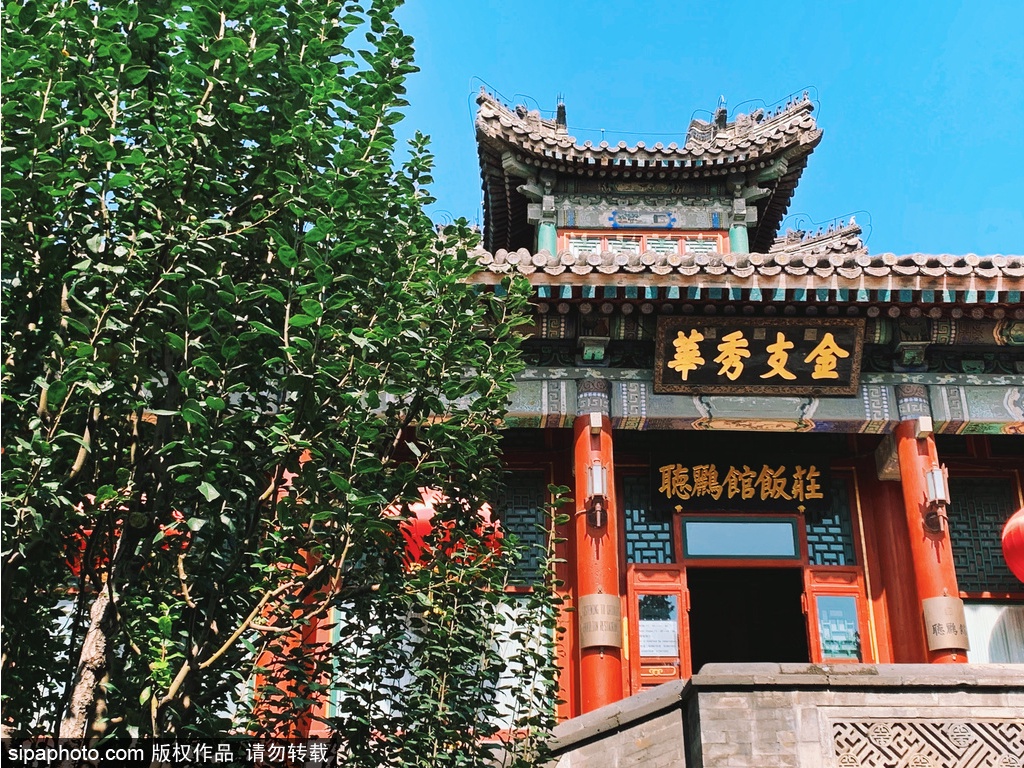
Initially built by Emperor Qianlong for his mother to watch operas, this theater with its two-storey stage was named the “Hall for Listening to Orioles” because in old times, people often compared beautiful voices to the singing of orioles. It was burned down by the Anglo-French Allied Forces in 1860 and was rebuilt during the reign of Emperor Guangxu. Before the completion of the Great Stage in the Garden of Virtue and Harmony, the Empress Dowager often watched operas and held banquets here. Now, the hall serves as a restaurant specializing in imperial court cuisine and has become famous for having received over a hundred foreign leaders.
Suzhou Street (Suzhou Jie)苏州街
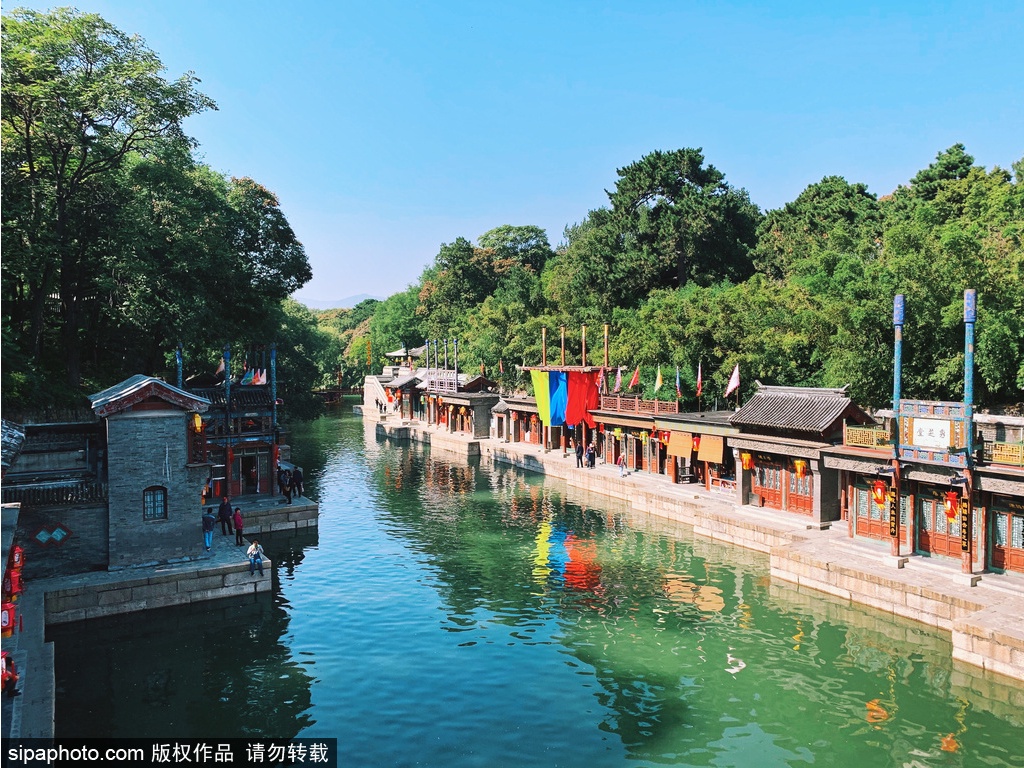
Originally called Merchants Street, it was built in the style of South China towns during Emperor Qianlong’s reign (1736-1795). A street where emperors and empresses could pretend to go shopping as ordinary people, it was burned to the ground by the Anglo-French Allied Forces in 1860 and restored in 1990. The 300-meter street is built over water with shops and stands on the bank. More than 60 businesses, including a teahouse, a restaurant, a pharmacy, a bank, a hat store, a jewelry store and a grocery store, operate on the bank, presenting a concentrated illustration of the commercialism in South China towns in the 18th century.
Clear and Peaceful Boat(Qingyan Fang)石舫
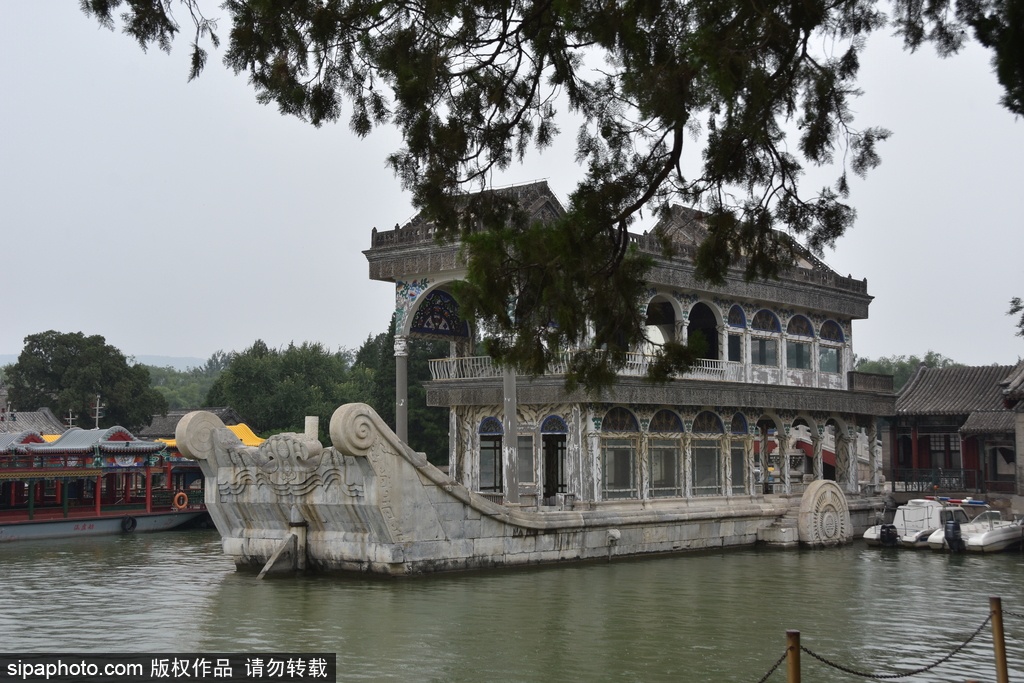
Initially called the Marble Boat, it was built in the 20th year of Emperor Qianlong’s reign (1755). The 36-meter boat was carved out of huge rocks. There was originally a Chinese-style cabin on the boat, which was burned down by the Anglo-French Allied Forces in 1860. When it was rebuilt in the 19th year of Emperor Guangxu’s reign (1893), the cabin was built in the western style and named the “Clear and Peaceful Boat” pursuant to the saying “Let the river be clear and the sea be peaceful”.
Touring route:
From the East gate:
·1.5 hours
East Palace gate — The Hall of Benevolence and Longevity — The Garden of Virtue and Harmony — The Hall of Jade Ripples — Yiyun Hall — The Hall of happiness and longevity — Long Corridor — The gate of Dispelling Clouds
·2 hours
East Palace gate — The Hall of Benevolence and Longevity — The Garden of Virtue and Harmony — The Hall of happiness and longevity — Long Corridor — The gate of Dispelling Clouds — Qingyanfang — Zhongyu road — Suzhou Street Bridge
·2.5 hours
East Palace gate — The Hall of Benevolence and Longevity — The Garden of Virtue and Harmony — The Hall of Jade Ripples — Yiyun Hall — The Hall of happiness and longevity — Long Corridor — The temple of Dispelling Clouds — Tower of the Fragrance of the Buddha — Suzhou Street Bridge
From the North gate:
·1.5 hours
The North gate — Suzhou Street Bridge — Zhongyu road — Tower of Cloud-Retaining Eaves — Qingyanfang — Long Corridor — Gates of parting clouds
·2 hours
The North gate — Suzhou Street Bridge — Zhongyu road — Tower of Cloud-Retaining Eaves — Qingyanfang — Long Corridor — Gates of parting clouds — The Hall of happiness and longevity — The Garden of Virtue and Harmony — The Hall of Benevolence and Longevity
·2.5 hours
The North gate — Suzhou Street Bridge — Tower of the Fragrance of the Buddha — The temple of Dispelling Clouds — Long Corridor — The Hall of happiness and longevity — Yiyun Hall — The Hall of Jade Ripples — The Garden of Virtue and Harmony — The Hall of Benevolence and Longevity
From the Xinjiangongmen gate:
·1.5 hours
Xinjiangongmen — Bronze Ox — East Causeway — Wenchang Tower — Hall of Benevolence and Longevity — Garden of Virtue and Harmony — Hall of Jade Ripples — Yiyun Hall — Hall of Happiness in Longevity — Gate for Greeting the Moon
·2 hours
Xinjiangongmen — Bronze Ox — East Causeway — Wenchang Tower — Hall of Benevolence and Longevity — Garden of Virtue and Harmony — Hall of Jade Ripples — Yiyun Hall — Hall of Happiness in Longevity — Long Corridor — The gate of Dispelling Clouds
·2.5 hours
Xinjiangongmen — Bronze Ox — East Causeway — Wenchang Tower — Hall of Benevolence and Longevity — Garden of Virtue and Harmony — Hall of Jade Ripples — Yiyun Hall — Hall of Happiness in Longevity — The temple of Dispelling Clouds — Tower of the Fragrance of the Buddha — Suzhou Street Bridge
Audio guide:
No matter you have an hour or half a day, it helps you to take full advantage of your visit the audio guide features:
• available in 19 languages — English, French, German,(add)
• self-guided tours for exploring the Summer Palace
• pick up one and return at any gate but the West gate
Price:
• 40 RMB with a 50 RMB refundable deposit
Availability:
• The audio guide is available every day
Restaurant:
The Hall of Listening to the Orioles
The ancient Chinese liken the warble of an oriole to beautiful songs and melodies, hence the name. It was used to be a theater. Banquet were held here when opera was performed once. Now the hall is one of the most famous, time-honored restaurant in China, featuring imperial dishes and desserts.It is a must for many foreign visitors to have lunch here when they come to Beijing. More than one hundred heads of state worldwide have dined here and the late Premier Zhou Enlai has held banquets here in honor of state guests.
Boating services:
We provides the tourists with a safe and enjoyable environment for recreational boating. There are three types of boat for tourists including pedalist boat and electric boat. Tourists can escape on a relaxing tour on Kunming Lake while experiencing the incredible natural beauty of the Summer Palace.
Don’t drink alcohol while boating



